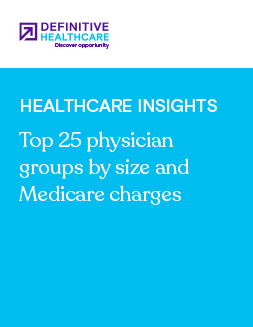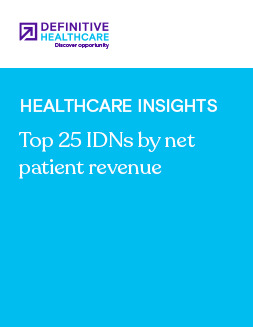Healthcare Insights
Hospitals with the highest total uncompensated care costs
In 2023, 25.3 million Americans under the age of 65 were uninsured, placing financial strain on hospitals nationwide. These uncompensated care costs reflect the burden of providing care that isn’t reimbursed by patients or insurers. With recent policy moves focused on cuts to Medicaid, there are concerns that the number of uninsured could rise in the U.S., deepening the financial challenges faced by healthcare providers. This article looks at the hospitals with the highest uncompensated care costs and considers the wider implications for the U.S. healthcare system.
What is uncompensated care?
According to the American Hospital Association (AHA), uncompensated care is an overall measure of hospital care provided for which no payment was received from the patient or insurer. Hospitals typically provide uncompensated care to patients who are uninsured, impoverished, or who otherwise cannot pay for their medical care. The AHA also states that U.S. hospitals have provided more than $620 billion in uncompensated patient care over the last 20 years.
Total uncompensated care includes unreimbursed Medicaid costs, the Children’s Health Insurance Program (CHIP), state and local indigent care programs, charity care for both insured and uninsured patients, and non-Medicare and non-reimbursable Medicare bad debt expenses.
Using Definitive Healthcare’s HospitalView product, we created a list of the top 10 hospitals with the highest total uncompensated care or unreimbursed costs as a percentage of total operating expenses (OPEX). While some large institutions report higher overall uncompensated care costs (by total dollar amount alone), this percentage-based metric provides a clearer picture of the relative financial burden each hospital faces based on its operational scale.
| Rank | Hospital name | City | State | Total uncompensated care unreimbursed costs | Net patient revenue | Total discharges | Total operating expenses | Uncompensated care as % of OPEX | Explore dataset |
|---|---|---|---|---|---|---|---|---|---|
| 1 | NYC Health and Hospitals - Queens | Jamaica | NY | $386,885,010 | $665,267,136 | 10,807 | $684,506,112 | 57% | Explore |
| 2 | NYC Health and Hospitals - Lincoln | Bronx | NY | $507,939,387 | $738,185,920 | 15,604 | $923,695,680 | 55% | Explore |
| 3 | NYC Health and Hospitals - Elmhurst | Elmhurst | NY | $562,964,140 | $917,565,120 | 17,138 | $1,044,490,496 | 54% | Explore |
| 4 | NYC Health and Hospitals - Bellevue | New York | NY | $857,312,261 | $1,359,531,648 | 24,585 | $1,698,901,376 | 50% | Explore |
| 5 | NYC Health and Hospitals - Metropolitan | New York | NY | $256,491,343 | $419,715,360 | 5,723 | $544,946,688 | 47% | Explore |
| 6 | NYC Health and Hospitals/South Brooklyn Health | Brooklyn | NY | $343,111,599 | $613,199,232 | 12,022 | $752,918,528 | 46% | Explore |
| 7 | NYC Health and Hospitals - Jacobi | Bronx | NY | $596,803,346 | $1,135,075,072 | 23,462 | $1,440,409,472 | 41% | Explore |
| 8 | NYC Health and Hospitals - Kings County | Brooklyn | NY | $517,236,636 | $1,095,416,704 | 15,245 | $1,302,092,032 | 40% | Explore |
| 9 | John H Stroger Jr Hospital of Cook County | Chicago | IL | $434,794,080 | $1,003,249,600 | 15,873 | $1,104,898,560 | 39% | Explore |
| 10 | John Peter Smith Hospital | Fort Worth | TX | $540,199,695 | $692,017,984 | 25,373 | $1,383,928,832 | 39% | Explore |
Fig. 1 Data is from the Definitive Healthcare HospitalView product and aggregated from the most recent 12-month interval tracked in our database, sourced from the Medicare Cost Report. Data accessed May 2025.
Which hospitals have the highest uncompensated care costs?
The list above highlights the top 10 hospitals with the highest uncompensated care costs as a percentage of their total operating expenses. By comparing uncompensated care costs to operating expenses, we assess how much of a hospital’s budget is consumed by treating patients who can’t pay.
While large hospitals may report high absolute uncompensated care costs, this percentage-based approach reveals which hospitals are most burdened by serving uninsured or underinsured populations.
For example, while NewYork-Presbyterian Weill Cornell Medical Center reported one of the highest total uncompensated care costs at $823 million, it did not appear in our top ten because that amount represents just 8% of its operating expenses. This means that, proportionally, it is less financially strained than hospitals where uncompensated care might consume 40–50% of operating expenses.
Many of the hospitals on our list, such as those in the NYC Health + Hospitals system, serve as safety-net providers in densely populated, high-need areas. The list also includes public hospitals in Chicago and Fort Worth, underscoring that this challenge spans geographic regions.
How is uncompensated care calculated?
Uncompensated care costs are calculated on a hospital-by-hospital basis.
First, the total uncompensated care charges are calculated by adding the hospital’s bad debts and its total charity care charges together. That number is then multiplied by the hospital’s cost-to-charge ratio, or the ratio of total expenses to gross patient and other operating revenue. The hospital’s uncompensated care costs are the resulting integer from this equation.
What are the effects of uncompensated care?
Uncompensated care places financial pressure on health systems, particularly those serving large uninsured or underinsured populations. Hospitals must absorb the cost of treating patients who cannot pay, which can lead to budget cuts, staff reductions, or even closures, especially in rural or safety-net facilities.
To offset these losses, some providers shift costs to privately insured patients, contributing to higher healthcare prices. Financial strain may also force hospitals to scale back critical but less profitable services, such as mental health care or community outreach programs.
These challenges can result in longer wait times, crowded emergency departments, and reduced access to care. Ultimately, uncompensated care exacerbates health disparities by disproportionately affecting underserved communities.
Learn more
Healthcare Insights are developed with healthcare commercial intelligence from the Definitive Healthcare platform. Want even more insights? Start a free trial now and get access to the latest healthcare commercial intelligence on hospitals, physicians, and other healthcare providers.


